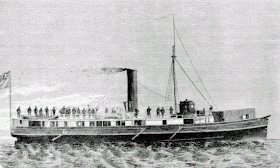 This is HMS Aurora in the winter of 1866-7. She is not trapped in the Antarctic, she is in Winter Quarters just outside Quebec city, Canada. Her upper spars and rigging have been removed, and she has been wrapped up as protection against the wind. A temporary suspension bridge formed from the ships cables links her mooring at Commissioners Wharf to the shore.
This is HMS Aurora in the winter of 1866-7. She is not trapped in the Antarctic, she is in Winter Quarters just outside Quebec city, Canada. Her upper spars and rigging have been removed, and she has been wrapped up as protection against the wind. A temporary suspension bridge formed from the ships cables links her mooring at Commissioners Wharf to the shore.But why was she there at all?
Protecting Canada
To deter raids from Fenian gangs into Canada the Royal Navy had deployed various units along the St Lawrence river during 1866 and 7 and the Aurora had been there since May 1866. Originally built in 1861, she was quite a new ship with 51 guns and screw powered, so she could navigate the local waters well. But in this period her main role was as a source of experienced naval crew, of which she carried 540.
Her crew were used to man gun boats patrolling the St Lawrence river,. These gunboats were mainly converted local craft such as the Rescue (under Lt Fairlie), Prince Alfred, and Michigan, purchased by the Canadian authorities and protected by boiler plates and heavy planking, armed with Armstrong ship guns and 9 and 12 pounders.
120 men were also sent by train down to Toronto in June 1866 to man the steamer Magnet and the gunboat Heron, for service on lake Ontario.
The Rescue
These "provincial gunboats" had originally been manned by the volunteer Toronto Naval Reserve, though even then the Aurora had made a contribution, a Toronto born midshipman home on leave, EB Van Koughnet, able to act as adviser to the commander, Captain McMaster.
The harsh Canadian winters meant that most waterways froze up, so the gunboats were laid up from November 1866 to March 67, and her crew returned to the Aurora.
In March 1867 her crew again manned gunboats, patrolling from Quebec up to Lake Ontario.
Prince Alfred - Lt. Archibald Douglas with 3 officers, 1 surgeon, 2 engineers and 64 men
Rescue - Lt Henry Fairlie with 2 officers, 2 engineers and 48 men.
Hercules, commanded by Lt Thomas Hooper with 2 officers, 2 engineers and 50 men.
The Prince Alfred
Quebec
Life on board the Aurora during the winter was hard. In Quebec temperatures can drop down to -30 during the winter, it is extremely cold! A constant battle had to waged to break up ice around the ship, cutting it into blocks to prevent it damaging the ship.
During the summer though, life for her crew had been rather more pleasant, at least for the skeleton crew not manning gun boats. According to the Illustrated London News
"The officers and men of the Aurora have, by their courtesy and efficient services they have rendered during their stay, become great favourites with the citizens.... The fine band has likewise lent it's aid at concerts for charitable purposes, as well as at citizen's balls."
This popularity was cemented during the Great Fire in the St Roch district in October, when over 2300 houses were destroyed. The
"officers and men vied with each other in their endeavours to save life and property".
Quebec City after the fire
In July the following year there was a minor diplomatic incident when the US ship Haze refused to salute the Aurora, as was normal courtesy.
The Aurora stayed on station until November 1867 when she returned to Plymouth.



No comments:
Post a Comment